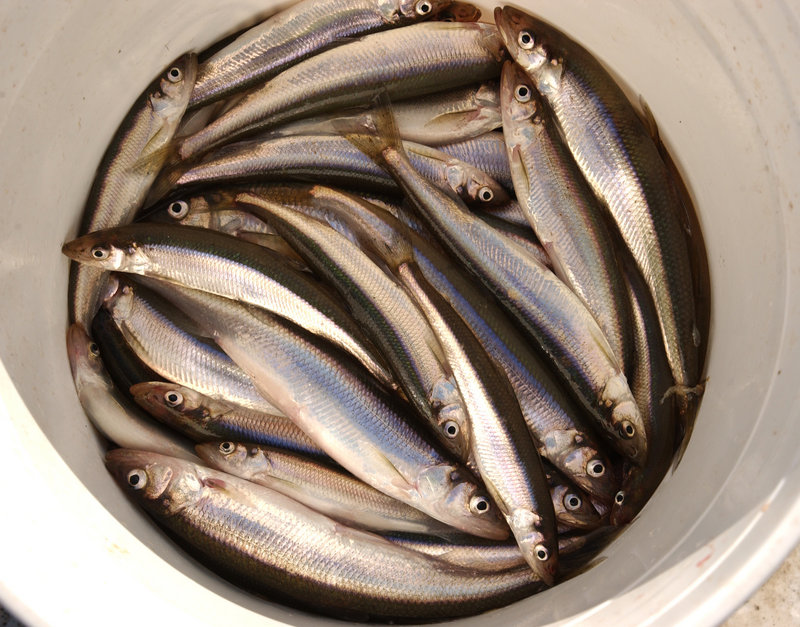On the way home one night last week, the early evening sunshine spoke of warmer days to come. Almost on cue, even with the car windows closed, I could hear spring coming alive outside.
I rolled down the window, and the chorus of peepers came flowing in, filling the car with sound. The peepers faded in and out as I drove the last mile home, sometimes faint, other times louder, but always there.
While most herald peepers as a sign that spring is here, dip netters know that once they hear the peepers, its time to get their gear ready because the smelt spawning run is set to start.
Rainbow smelt are found in Maine’s landlocked waterways, inhabiting lakes and ponds, and they also inhabit Maine’s saltwater bays and estuaries. Once winter wanes and spring bursts forth, smelt look to spawn in lake tributaries and tidal rivers.
The spawning run can be brief. While spawning may occur over a period of a couple of weeks, the peak run can be over in just a week, so the sounds of peepers are a welcome clue that it is time to get ready.
Most tidal rivers on Maine’s coast have smelt runs. Sea-run smelts are anadramous and spend their adult live in a saltwater environment, coming back to freshwater tidal rivers to spawn in the spring. Most smelt spawn at three years old, although there are some younger and older spawners.
At night, often influenced by the large, full moon tides, smelt will come to the head of the tide area in rivers and congregate as they prepare to spawn. This can be as much as up to two hours on either side of high tide. In fresh water, smelt travel at night and spawn at the base of falls or rapids that they can not pass.
Smelt look for rocky, gravelly bottoms where there is some current, and males will gather around the female. As females start to drop their eggs, the males will fertilize them. The fertilized eggs are extremely sticky and will adhere to almost anything, including gravel, sand, rocks and weeds.
It is as they prepare to spawn that they are most susceptible to an angler’s dip net. For many Mainers, dipping for smelts is as much a sign of spring as fiddlehead bursting forth. Dipping for smelts can be a fairly social affair, as anglers will summon friends and family to go smelting. On rivers with easy access, you can see dozens of dip netters lining the banks.
Techniques vary, but the gear is essentially the same. You net with a long handled net. These nets are usually 18 inches in diameter with a fine mesh netting and an aluminum or wooden pole eight feet in length. You can purchase these at many area sporting stores this time of year.
Along with the net, a leak-proof pair of hip boots or waders to keep out the frigid water is essential. If they are leaking, you will not last long. Of course, you will also need some means to illuminate the water where you are scooping. Years ago, the favorite means of illumination was a green Coleman lantern. Usually this was held by another angler or a post was driven into the mud to hold the lantern. While not waterproof, they are hardy. Many an angler has a story of how after knocking over the lit lantern into the water, all they had to do was replace the soggy mantles and it lit right back up. Nowadays, battery-powered headlamps are the primary choice of anglers.
Where to go is often the most-asked question, and smelters are notoriously tight-lipped and secretive about their favorite dipping spots. Last Saturday night, as I drove by one of my favorite streams, I could see a faint light along the stream bank.
Once I stopped, the light quickly was extinguished by whoever was there, fearful that they may give away their spot. Of course, three nights before, the local marine patrol officer said that there were more than 20 anglers at that discreet spot. I guess anything over 20 is too many.
Before you do go, make sure you check the regulations for the stream that you intend to fish. Smelt are an extremely valuable resource for recreational anglers, as a forage fish for trout and salmon, and commercially for bait dealers. Thus, they are regulated in order to protect them, and many areas are closed to the taking of smelt by dipping. The bag limit is two quarts of smelt for each dip netter.
Two quarts of smelts is plenty for a feed, and there are few things that taste better than freshly caught smelts rolled in seasoned cornmeal and flour and quickly fried. Of course, pan-fried brook trout with a few fresh fiddlehead certainly comes close, but we’ll save that for another column.
Mark Latti is a former public information officer for the Maine Department of Inland Fisheries and Wildlife and a registered Maine Guide. He can be reached at:
mlatti@gmail.com
Send questions/comments to the editors.



Success. Please wait for the page to reload. If the page does not reload within 5 seconds, please refresh the page.
Enter your email and password to access comments.
Hi, to comment on stories you must . This profile is in addition to your subscription and website login.
Already have a commenting profile? .
Invalid username/password.
Please check your email to confirm and complete your registration.
Only subscribers are eligible to post comments. Please subscribe or login first for digital access. Here’s why.
Use the form below to reset your password. When you've submitted your account email, we will send an email with a reset code.